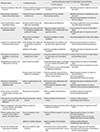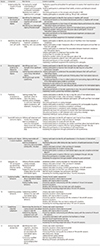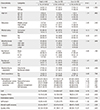Abstract
Purpose
This study was done to develop a internalized stigma reducing program based on cognitive-behavioral therapy and appropriate for patients with schizophrenia and to evaluate its effectiveness.
Methods
The study design was a mixed method research. Qualitative study, 13 patients with schizophrenia who had experience in overcoming stigma were purposively chosen for interviews and data were analyzed using Giorgi method. Quantitative study, 64 patients with schizophrenia (experimental group=32, control group=32) were recruited. The cognitive-behavioral therapy-based program for reducing internalized stigma in patients with schizophrenia was provided for 8 weeks (12 sessions). Data were collected from June. 20, 2013 to Feb. 14, 2014. Quantitative data were analyzed using χ2-test, t-test, repeated measures ANOVA with the SPSS program.
Results
Qualitative results, from the experience of coping with stigma in patients with schizophrenia seventeen themes and five themes-clusters were drawn up. Quantitative results showed that internalized stigma, self-esteem, mental health recovery and quality of life were significantly better in the experimental group compared to the control group.
Notes
References
1. Kim SW, Yoon JS, Lee MS, Lee HY. The analysis of newspaperarticles on psychosis. J Korean Neuropsychiatr Assoc. 2000; 39(5):838–848.
2. Crisp AH, Gelder MG, Rix S, Meltzer HI, Rowlands OJ. Stigmatisation of people with mental illnesses . Br J Psychiatry. 2000; 177:4–7. DOI: 10.1192/bjp.177.1.4.
3. Corrigan PW, Watson AC. The paradox of self-stigma and mental illness. Clin Psychol. 2002; 9(1):35–53. DOI: 10.1093/clipsy.9.1.35.
4. Rüsch N, Corrigan PW, Wassel A, Michaels P, Olschewski M, Wilkniss S, et al. A stress-coping model of mental illness stigma: I. Predictorsof cognitive stress appraisal. Schizophr Res. 2009; 110(1-3):59–64. DOI: 10.1016/j.schres.2009.01.006.
5. Fung KM, Tsang HW, Cheung WM. Randomized controlled trial of the self-stigma reduction program among individuals with schizophrenia. Psychiatry Res. 2011; 189(2):208–214. DOI: 10.1016/j.psychres.2011.02.013.
6. Knight MTD, Wykes T, Hayward P. Group treatment of perceived stigma and self-esteem in schizophrenia: A waiting list trial of efficacy. Behav Cogn Psychoth. 2006; 34(3):305–318. DOI: 10.1017/S1352465805002705.
7. Yanos PT, Roe D, West ML, Smith SM, Lysaker PH. Group-based treatment for internalized stigma among persons with severe mental illness: Findings from a randomized controlled trial. Psychol Serv. 2012; 9(3):248–258. DOI: 10.1037/a0028048.
8. WHO Collaborating Center for Psychosocial Rehabilitation and Community Mental Health. Patient empowerment programme for schizophrenia. 3rd ed. Yongin: Yongin Mental Hospital WHO Collaborating Center for Psychosocial Rehabilitation and Community Mental Health;2012. p. 136.
9. Lee WK, Hwang TY. Efficacy of a group treatment, self-stigma overcome programs for inpatients with schizophrenia. J Korean Neuropsychiatr Assoc. 2010; 49(5):444–452.
10. Ko KH, Yang SH, Kim YA, Kwon MS, Bang SH, Lee JM, et al. The effects of an empowerment program for chronic schizophrenic patients on their empowerment and internalized stigma. J Korean Acad Psychiatr Ment Health Nurs. 2008; 17(4):491–499.
11. Brohan E, Elgie R, Sartorius N, Thornicroft G. Self-stigma, empowerment and perceived discrimination among people with schizophrenia in 14 European countries: The GAMIAN-Europe study. Schizophr Res. 2010; 122(1-3):232–238. DOI: 10.1016/j.schres.2010.02.1065.
12. Dickerson FB, Tenhula WN, Green-Paden LD. The token economy for schizophrenia: Review of the literature and recommendations for future research. Schizophr Res. 2005; 75(2-3):405–416. DOI: 10.1016/j.schres.2004.08.026.
13. Kurtz MM, Mueser KT. A meta-analysis of controlled research on social skills training for schizophrenia. J Consult Clin Psychol. 2008; 76(3):491–504. DOI: 10.1037/0022-006x.76.3.491.
14. Fotoukian Z, Shahboulaghi FM, Khoshknab MF, Mohammadi E. Concept analysis of empowerment in old people with chronic diseases using a hybrid model. Asian Nurs Res (Korean Soc Nurs Sci). 2014; 8(2):118–127. DOI: 10.1016/j.anr.2014.04.002.
15. Park BS, Bae SW. Development of psychosocial rehabilitation service assessment and outcome scale: Focusing on psychosocial rehabilitation model. Ment Health Soc Work. 2013; 41(1):114–142.
16. Endicott J, Spitzer RL, Fleiss JL, Cohen J. The global assessment scale. A procedure for measuring overall severity of psychiatric disturbance. Arch Gen Psychiat. 1976; 33(6):766–771.
17. Yi JS, Chung MH, Lee BW, Lee SI. Reliability and validity of the Korean version of global assessment of functioning scale. Schizophr Clin. 2003; 6(2):118–124.
18. Kay SR, Fiszbein A, Opler LA. The positive and negative syndrome scale (PANSS) for schizophrenia. Schizophr Bull. 1987; 13(2):261–276.
19. Yi JS, Ahn YM, Shin HK, An SK, Joo YH, Kim SH, et al. Reliability and validity of the Korean version of the positive and negative syndrome scale. J Korean Neuropsychiatr Assoc. 2001; 40(6):1090–1105.
20. Ritsher JB, Phelan JC. Internalized stigma predicts erosion of morale among psychiatric outpatients. Psychiatry Res. 2004; 129(3):257–257.
21. Hwang TY, Lee WK, Han ES, Kwon EJ. A study on the reliability and validity of the Korean version of internalized stigma of mental illness scale (K-ISMI). J Korean Neuropsychiatr Assoc. 2006; 45(5):418–426.
22. Rosenberg M. Society and the adolescent self-image. Princeton, NJ: Princeton University Press;1965. p. 347.
23. Jon BJ. Self-esteem: A test of its measurability. Yonsei Nonchong. 1974; 11:107–130.
24. Bullock WA. The mental health recovery measure. In : Campbell-Orde T, Garrett E, Leff S, editors. Measuring the promise of recovery: A compendium of recovery and recovery related instruments, Part II. Cambridge, MA: The Evaluation Center@HSRI;2005. p. 36–41.
25. Song GO. Validation of the Korean version of the mental health recovery measure. Ment Health Soc Work. 2010; 34(4):154–188.
26. Min SK, Lee CI, Kim KI, Suh SY, Kim DK. Development of Korean version of WHO quality of life scale abbreviated version (WHOQOL-BREF). J Korean Neuropsychiatr Assoc. 2000; 39(3):571–579.
27. Giorgi A. The theory, practice, and evaluation of the phenomenological method as a qualitative research procedure. J Phenomenol Psychol. 1997; 28(2):235–260. DOI: 10.1163/156916297X00103.
28. Lucksted A, Drapalski A, Calmes C, Forbes C, DeForge B, Boyd J. Ending self-stigma: Polit evaluation of a new intervention to reduce internalized stigma among people with mental illnesses. Psychiatr Rehabil J. 2011; 35(1):51–54. DOI: 10.2975/35.1.2011.51.54.




 PDF
PDF ePub
ePub Citation
Citation Print
Print






 XML Download
XML Download